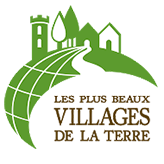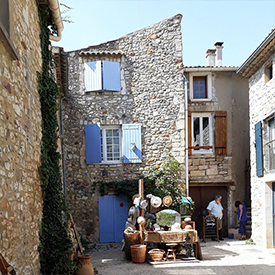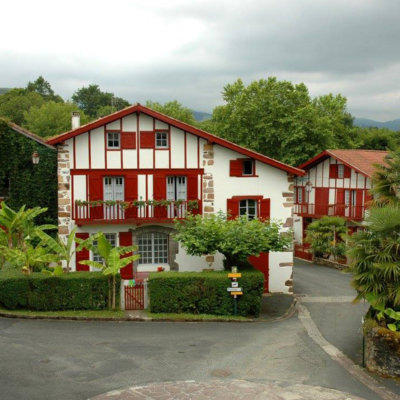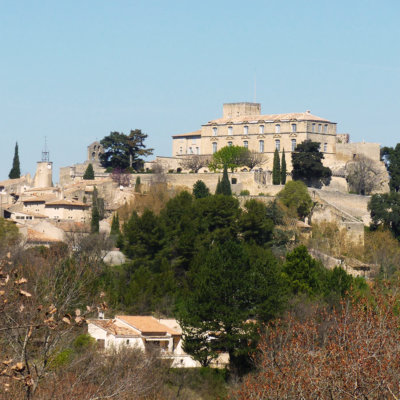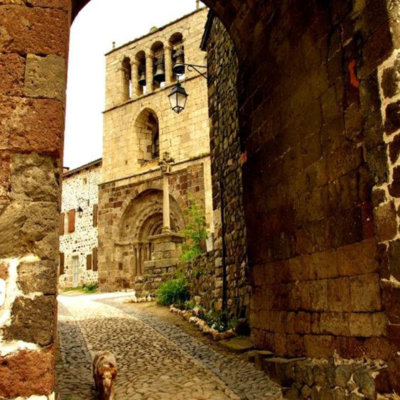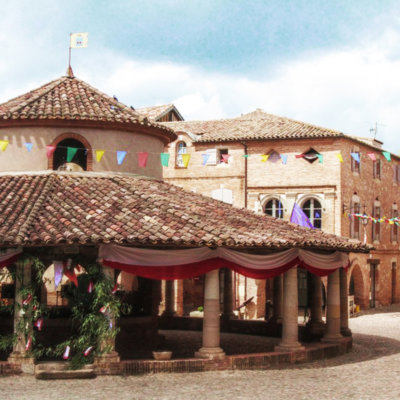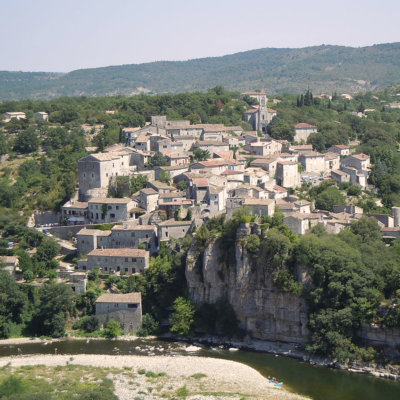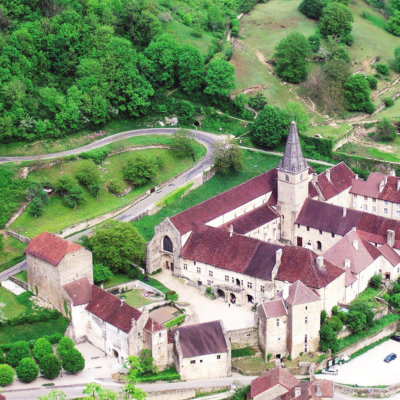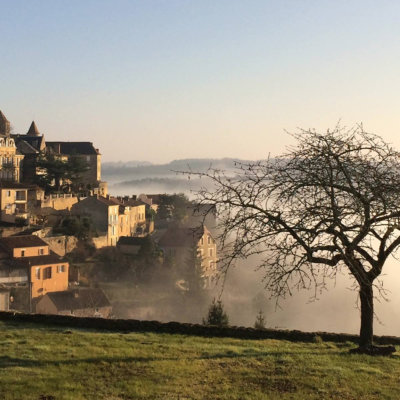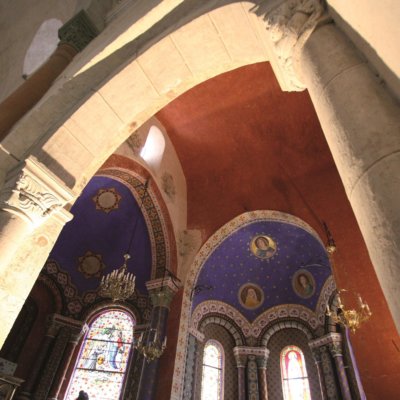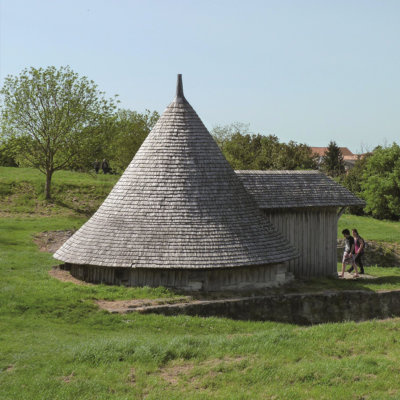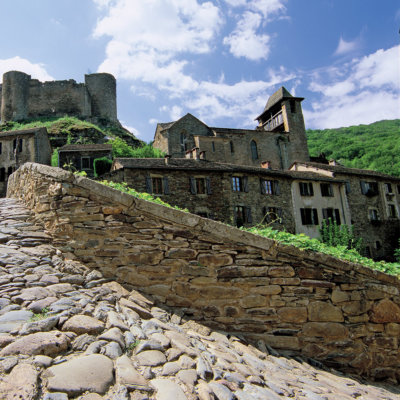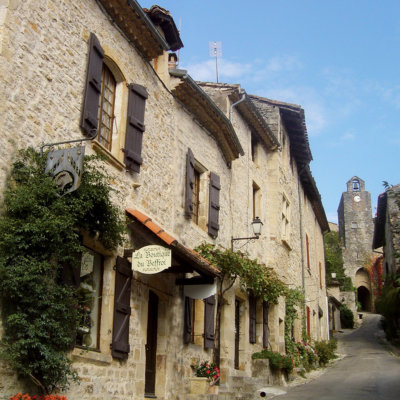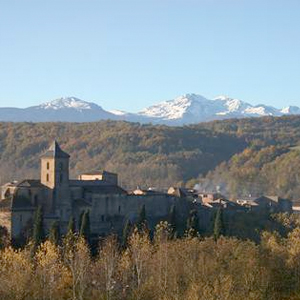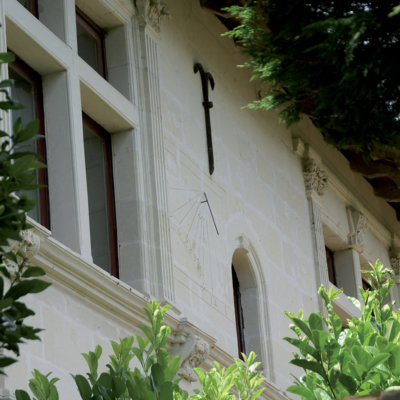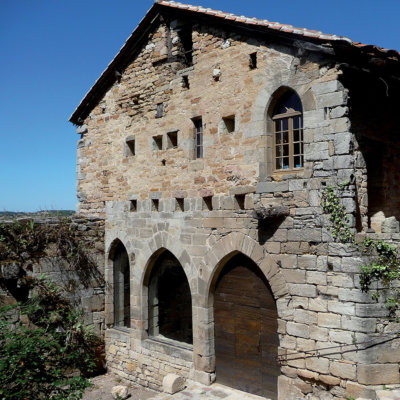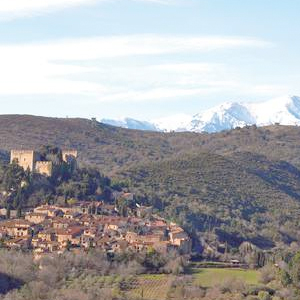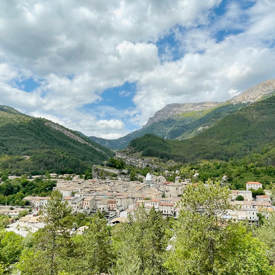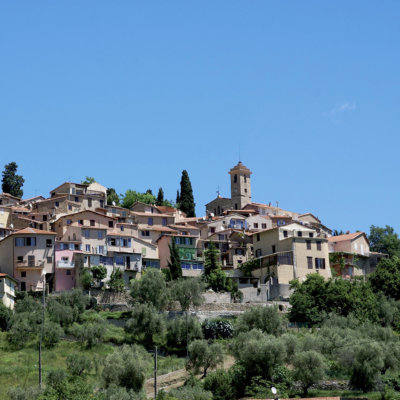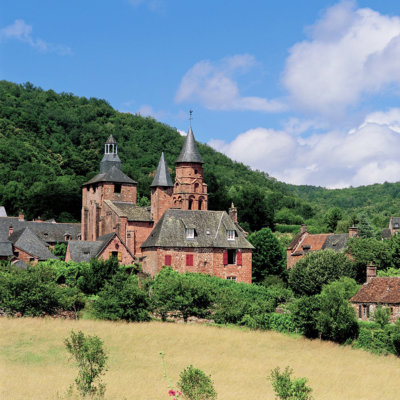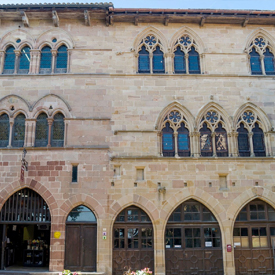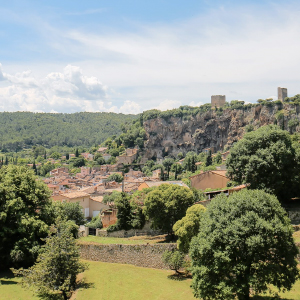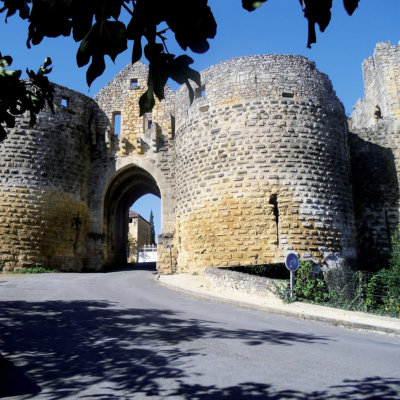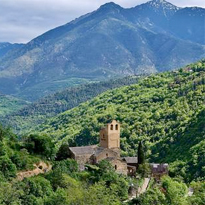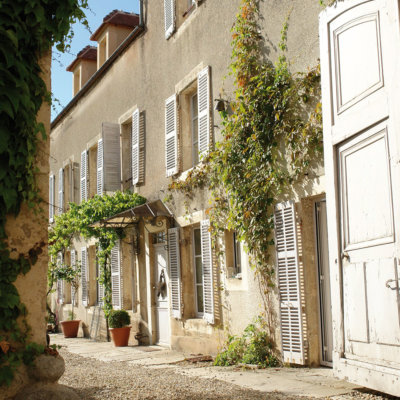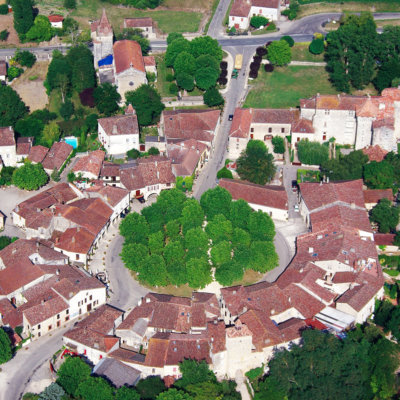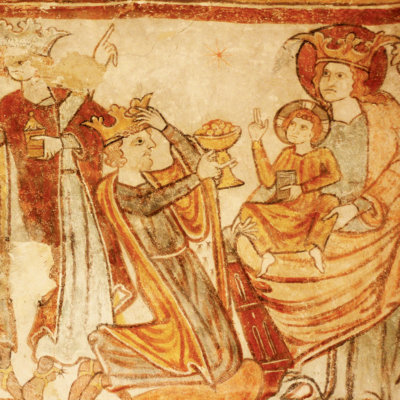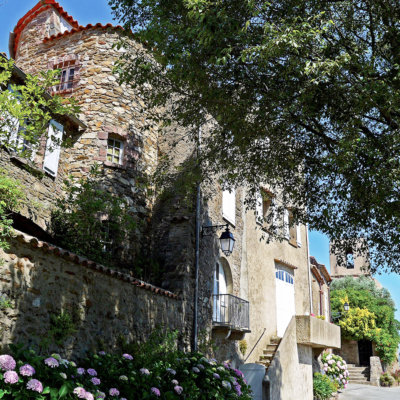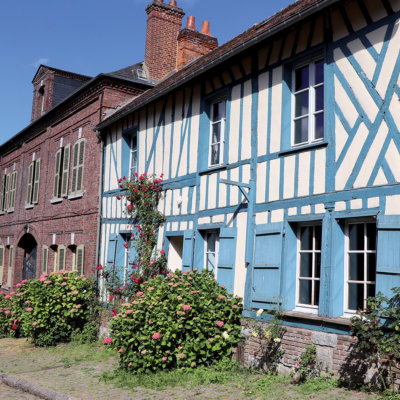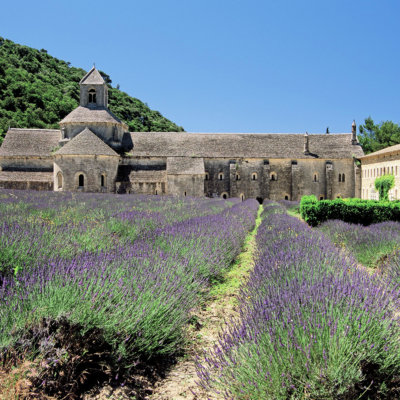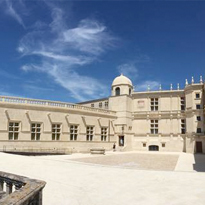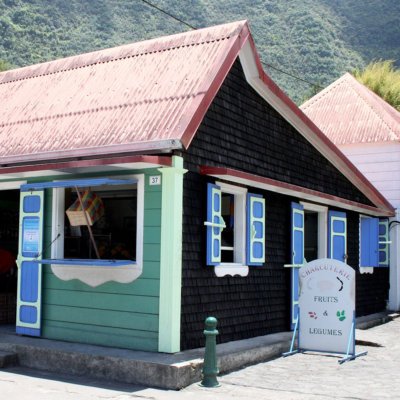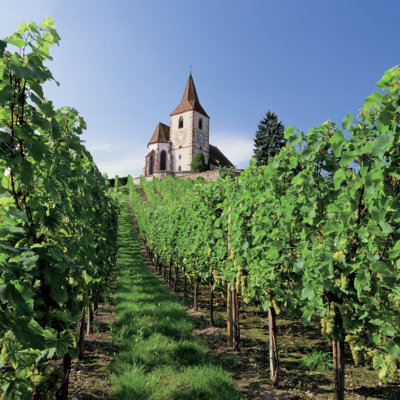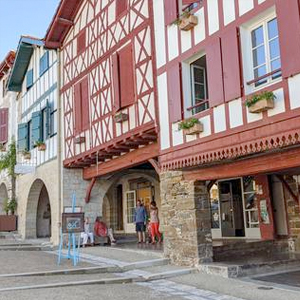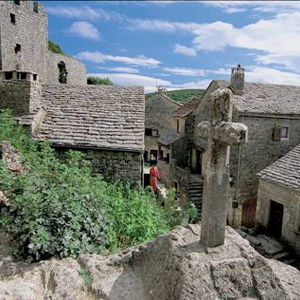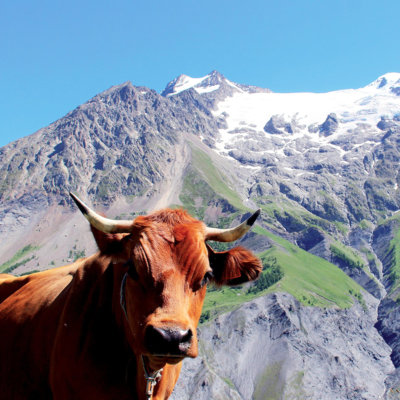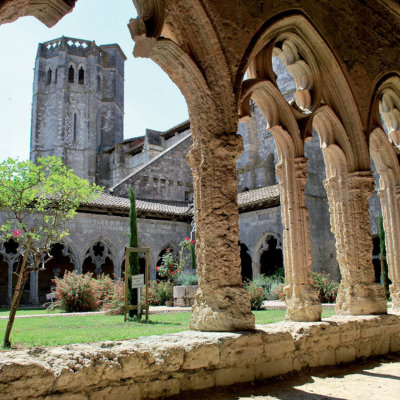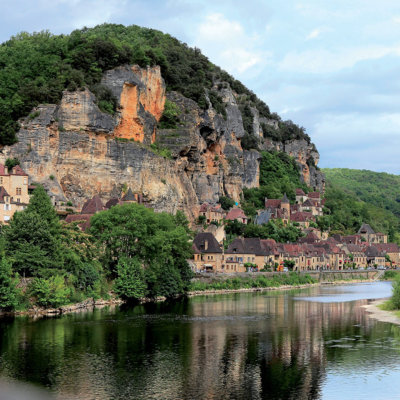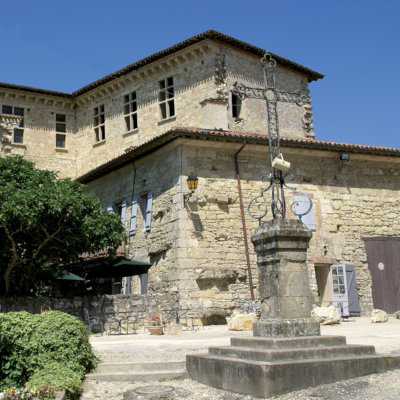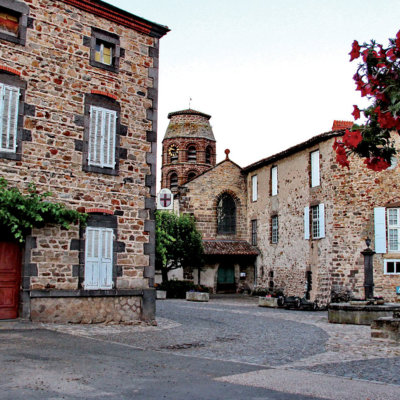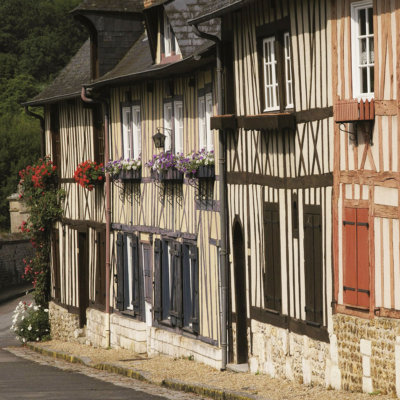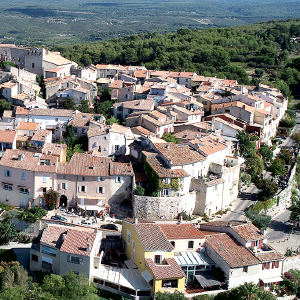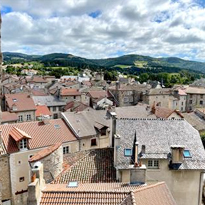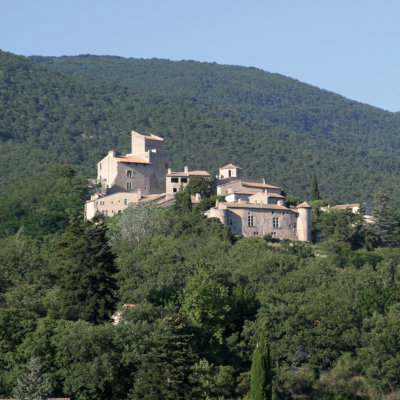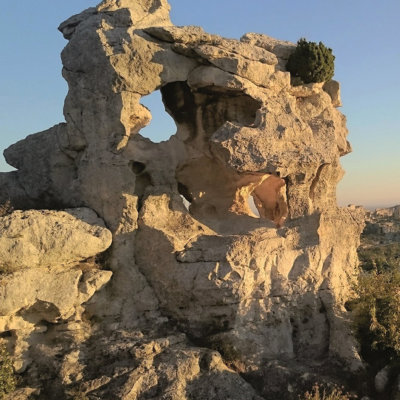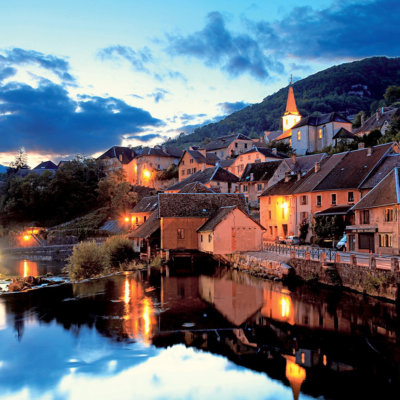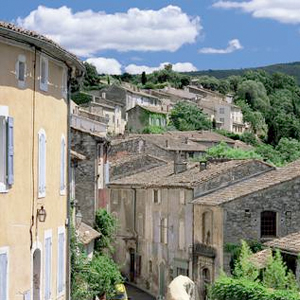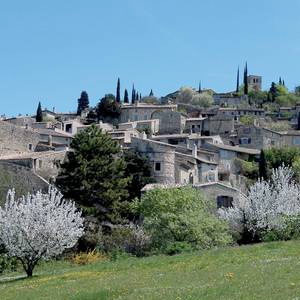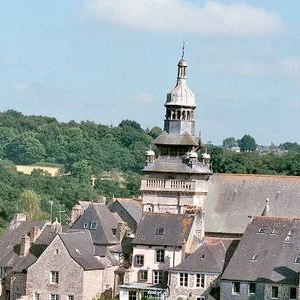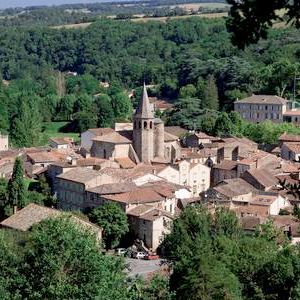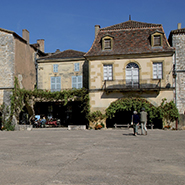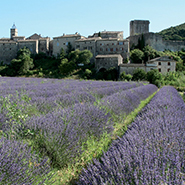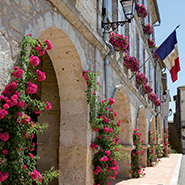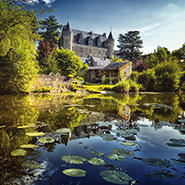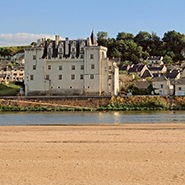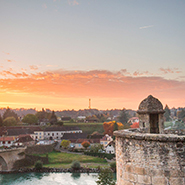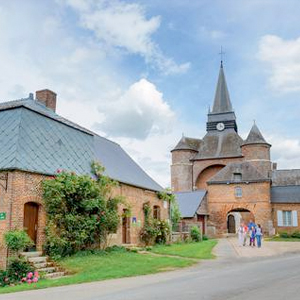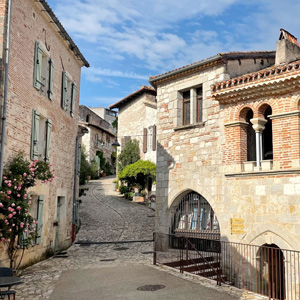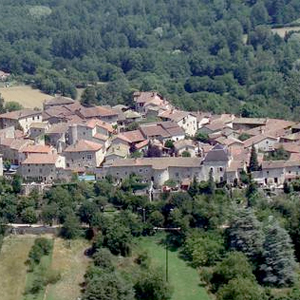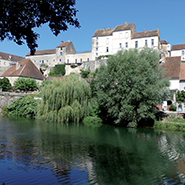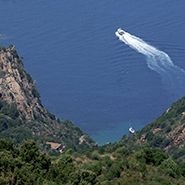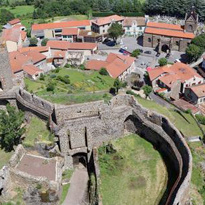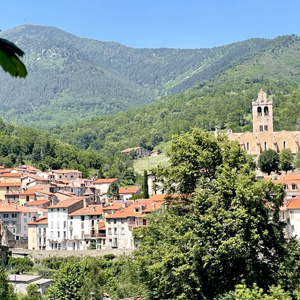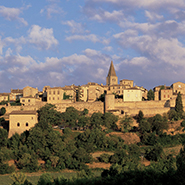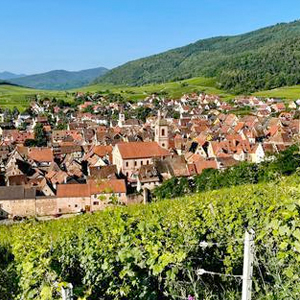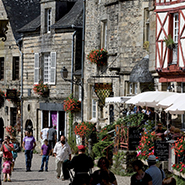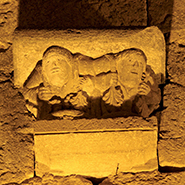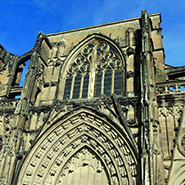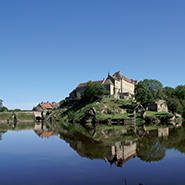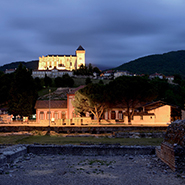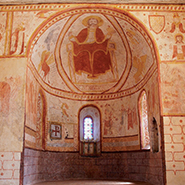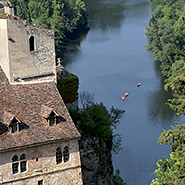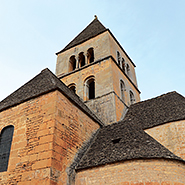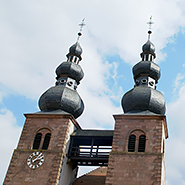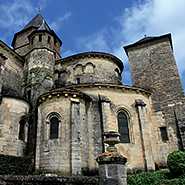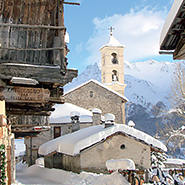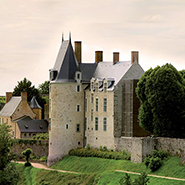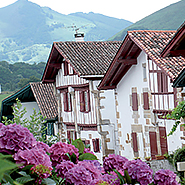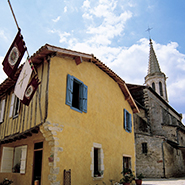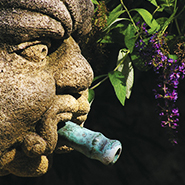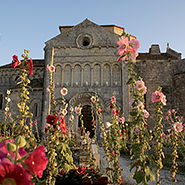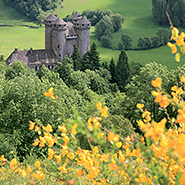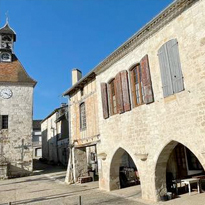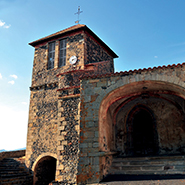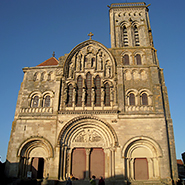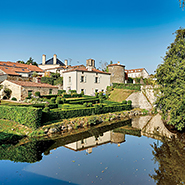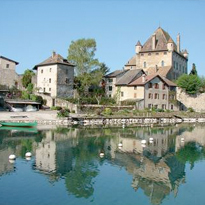The story of Les Plus Beaux Villages de France began with an encounter in 1981 between a man, Charles Ceyrac, Mayor of Collonges-la-Rouge, and a book about beautiful French villages.
Thanks to that book, the Mayor found a way to serve a cause about which he felt very strongly:
Unite energies and passions to protect and promote the outstanding heritage of these exceptional villages of France, and thereby provide them with an alternative to rural exodus. Sixty six mayors followed Charles Ceyrac in an adventure that was made official on the 6th of March 1982. The foundational objectives have not changed since then: to protect, promote and develop the most beautiful villages in France.
As a certificate of quality, the classification (listed village) guarantees the public the beauty embodied by its registered trade mark. Its aim is to incite permanent action towards making each village a place of exception where harmony between site, architecture, heritage and landscape is source of emotion and enjoyment, whether one lives there or visits.
• After the Commune (village) applies to be listed, it undergoes a survey visit on a date agreed upon by the Mayor and the Association’s Quality Manager.
• This survey is based on a grid of 27 objective criteria used to appraise the village’s heritage, architectural, urbanistic, and environmental qualities, as well as its efforts to make the most of its territory (aesthetic development, management of visitors’ flows, town planning tools…).
• Based on the on-site evaluation report and the photographic presentation, the Quality Committee decides to admit or reject the application. While this selection method is extremely rigorous – less than one classification application out of five is favourably accepted – it has really proved to be necessary for the villages and the network to remain credible in the promise of excellence they make to the wider public.
Because listing is not an end in itself, periodic re-evaluations are conducted every six years.
Since its inception, the association “Les Plus Beaux Villages de France” has firmly established its strategy around these three points: to preserve and enhance the quality of the heritage in the villages so as to increase their reputation while controlling the number of visitors and consequently fostering the development of economic activity linked to tourism.
THE VILLAGES
It is in the hollow of a circus, in the “causse” between Figeac and Gramat, that AUDE has installed its square dovecotes, its brown tiles, as well as its mansions and manor houses. On these arid lands, only the Autoire, torrent that gave its name to the village, brings the freshness of its waterfalls.
Perched on a cliff overlooking the Ardèche, the former stronghold of the “Lords of Balazuc” has kept many traces of its medieval past: maze of winding streets, vaulted passages are, with the castle, the fortified Romanesque church and the gates of enclosure, the original decoration of the village.

10 km south-west of Sarlat, on the banks of the Dordogne, Beynac-et-Cazenac reveals its imposing castle, once besieged by Richard Coeur de Lion, at the foot of which rest the houses with lauze roofs and blond facades .
Houses of stone or wood, with corbelling or half-timbering, turrets, geminate or mullioned windows, arched doors, flowery alleys … It is a multitude of details that appeal to Bruniquel. This former halt on the paths of Saint-Jacques on the borders of Quercy, Albigeois and Rouergue has also preserved castles and ramparts.
It is in the hollow of a valley Ariège, in a loop of the river Hers that Camon was born, the creation of an abbey in the Xth century which will later become a fortified priory. It is by the old arched door of the church that one enters today in the village to discover these witnesses of the religious past of Camon and its houses with Roman tiles.
Located a few kilometers from Figeac, the medieval fortress of Capdenac-le-Haut stretches along a rock shaped peninsula, overlooking over 110 meters a meander of the Lot. If the village remains marked by its medieval past, it appears in a good place among oppida of Quercy, claiming the title “Uxellodunum”, seat of the last Gallic battle led by Caesar.
On the banks of the Dordogne, Renaissance houses with carved windows and brown roofs entangled around a Cluniac priory of the eleventh century where Fenelon lived. Near the Romanesque church and its cloister, the castle of the Deans invites you to discover the riches of the Country of Art and History of which Carennac is a part.

About ten kilometers from Sarlat, Castelnaud-la-Chapelle overlooks the confluence between the Dordogne and the Céou in a splendid panorama facing its neighbors of Beynac-et-Cazenac and La Roque-Gageac. Known for its two castles, the beautifully restored castle housing the War Museum in the Middle Ages and the castle Milandes, former property of Josephine Baker.
About 20 kilometers southwest of Perpignan, Castelnou is located at the foot of the Aspres with, in the background, the Canigou, mythical mountain Catalans. Dominating the village, the Château Vicomtal has had to adapt its pentagonal shape to the steep and irregular ridges of the rock that welcomes it.
Overseeing the plain and the Burgundy canal, Châteauneuf and its imposing 12th century castle testify to the strategic position of the village between Dijon and Autun. The medieval streets reveal the houses of the rich Burgundy merchants of the fourteenth, fifteenth and sixteenth centuries.
At 650 m altitude, not far from the Mercantour National Park, Coaraze is the “village of the sun”. Sloping cobbled streets, vaulted passageways, stone houses, blue, yellow, pink, Italian-style and flower-filled squares attracted many artists and personalities, some of whom, such as Jean Cocteau or Ponce de Léon, signed the dials solar of the village.
It is in this flamboyant city of the Corrèze countryside that was born the idea of the “Most Beautiful Villages of France”, thought by its former mayor Charles Ceyrac. Its incomparable red sandstone sign the original identity of this former stronghold of the Counts of Turenne. It is everywhere, under the roofs of lauze or slate of the noble houses of XV and XVIth centuries, of the hall with the grains and the wines or the church Saint-Pierre.
In the heart of the Lot valley, this must-see stop on the Saint-Jacques paths is full of treasures: around the half-timbered houses, the abbey church Sainte-Foy from the 11th and 12th centuries, its 250 capitals, its contemporary stained glass windows by Pierre Soulages and its tympanum with 124 characters carved in the representation of the Last Judgment, but also the Treasury, that of Sainte-Foy, reliquary covered with gold and precious stones …
Located at the foot of an impressive tuff cliff from where you can enjoy an exceptional view of the Mediterranean landscapes, the village reveals a rich and varied heritage: its Notre-Dame-des-Grâces sanctuary dedicated to the Virgin (one of the most visited in the department), its monastery of San José, its 17 fountains, its semi-troglodyte habitat…
In the heart of Touraine, in the valley of Manse, this old chatellenie belonging to the island Bouchard and the archbishopric of Tours has preserved the ruins of its castle of the XVth century, its church of the XVIth century which contains the tomb of Katerine du Bellay, cousin of the poet Joachim du Bellay, and its white tufa dwellings with square turrets, mullioned windows and ornate windows stand out.
At the southern end of the Corrèze, not far from the Lot, Curemonte stretches along a ridge overlooking the valleys of Sourdoire and Maumont. In addition to the round or square towers of its three castles its Romanesque church of the twelfth, the village has preserved some noble houses and a hall dating from the early nineteenth century housing a cross of the sixteenth S.
About ten kilometers south of Sarlat, Domme is perched on a vertiginous cliff that allows you to enjoy an exceptional view of the Dordogne valley and the most beautiful villages near La Roque-Gageac and Beynac-et-Cazenac . This bastide with golden stones marries with success architectural, natural and gastronomic heritage of the Périgord Noir.
A few steps from Colmar, Eguisheim, cradle of the Alsatian vineyard, winds in concentric circles around the village where Pope Leo IX was born. Inside, along the cobblestone streets, the village, awarded at the national and European level for the quality of its flowering, reveals to the conquered eyes the beauty of its houses of the sixteenth and seventeenth centuries with pointed roofs, bright colors and half-timbered facades.
At the foot of the Aubrac mountains, not far from the Lot and Truyère gorges, pilgrims en route to Compostela take the Estaing gothic bridge before discovering its castle and the story of an illustrious family of lords. One of them distinguished himself by saving the life of King Philip Augustus to Bouvines who then granted the village the right to wear on its arms the royal fleur-de-lis.
Between the Conflent Valley and Mount Canigou, Eus offers its facades down terraces in the warm Catalan sun, complicit of lush vegetation. This former defensive site had to repel the French in the sixteenth century and the Spanish army in the eighteenth century. Today, instead of the old citadel is the imposing church of St. Vincent at the foot of which sloped the narrow streets paved with pebbles.
Attached to the village of Olette, the hamlet of Evol is dominated by the former fortress of the viscounts of So and the bell tower of its Romanesque church. The mountain identity still marks the village today by the pastoral activity and houses with shale walls and slate roofs whose size occupied the inhabitants in winter.
Built around a Benedictine abbey founded in the 8th century, this Burgundy town tells its medieval history through its ramparts, fortified gates, cobbled streets, houses and hotels… but also its aniseed sweets still made in the old abbey and whose smell welcomes you on your arrival.
Built around a castle now replaced by a square shaded by plane trees, Fourcès is an original round bastide whose houses create a theatrical decor of half-timberings and arcades. In addition to some gastronomic delights unavoidable in this land Gascon, the village also attracts by some flagship events such as its Flower Market in April or “Marciac in Fourcès” from the now famous jazz festival.
In the green valley of the Creuse, this Berrichon village so much loved by George Sand has welcomed many painters seduced by the romantic vision of its houses with sloping roofs harmoniously grouped around the Romanesque church and the castle. Gargilesse today keeps an intense cultural activity in a simple and warm atmosphere.
It is after having climbed the flowery alleys with pastel-colored walls that you will be able to take advantage of the exceptional panorama on the gulf of Saint-Tropez and the massif of the Moors that offers the place Deï Barri. A place where it is also pleasant to stop to enjoy a dish accompanied by a Côte de Provence at one of the restaurant terraces of the village …
Picardy and Normandy are found in the houses of Gerberoy, where half-timbered cobblestones and bricks are mixed in a charming mixture that seduced the post-impressionist painter Henri le Sidaner. It is to him that the village owes some of its charms: beautiful Italian gardens and the Fête des Roses organized every year since 1928 with a success that continues unabated.
Clinging to the side of the Vaucluse plateau, overlooking the plain of Cavaillon, the houses of Gordes lie at the foot of its imposing Renaissance castle and its church over tortuous cobbles. Village of artists celebrated by Marc Chagall, Victor Vasarely or Pol Mara, Gordes is an essential cultural stop in Provence.
Hung on top of a vertiginous cliff at an altitude of 760m, Gourdon is an open balcony overlooking the Gorges du Loup and the Mediterranean. Massed behind an imposing castle surrounded by gardens designed by Le Nôtre, the old houses have been well preserved and restored in this lively village animated by craftsmen.
Half-timberings on sparkling white walls, sloping roofs and geraniums on the windows. The imposing Hunspach houses, typical of the Wissembourg region, line the main street of the village. Some of them have kept what is special about Hunspach: the rounded glass of viotres that allow its inhabitants to see without being seen.
Fondée en 1314 par Louis 1er roi de Navarre et futur roi de France pour s’offrir un débouché sur la mer « Bastida de Clarenza » reste marquée par la diversité de population et de religion que son statut lui apporta. Façades blanches rayées de vert ou de rouge rappellent néanmoins que l’on est en Pays Basque.
On the high plateau of Causses du Larzac, La Couvertoirade tells several stories: that of the Knights Templar who built the castle in the twelfth century, the Hospitallers who, in the fifteenth century, succeeded them and locked the city in a crown of ramparts and that of the economic and demographic peak of the village with its beautiful houses of the sixteenth and seventeenth centuries.
Un joli port de pêche… et de plaisance ! Avec sa jetée en arrondi construite en 1840 et longue de 200 m, La Flotte vit au rythme du ballet des bateaux qui animent les quais toute l’année. A l’intérieur, les ruelles paisibles et fleuries alignent ses maisons basses dont la blancheur des murs offre un fond lumineux aux tableaux des volets verts ou bleus.
About twenty kilometers south of Montélimar, the white stones of La Garde-Adhémar dazzle the sun of the Drôme Provençale. From the top of its limestone spur, the village, which has kept its medieval ramparts, remains of the castle and old houses, offers an unobstructed view of the Rhone Valley and the mountains of Vivarais.
In an atmosphere worthy of certain landscapes of Scotland, La Garde-Guerin dominates, from the top of its plateau, the impressive Chassezac canyon. Former strategic site on the Regordane Way linking the coasts of Languedoc to the Massif Central, the village was attacked several times but kept its watchtower as well as its habitat and its cobbled streets.
In the heart of the Ecrins massif, facing the imposing peak of Meije and its 3 983 m altitude, the village of La Grave has installed its stone houses and slates on a sunny side. A major mountaineering destination, La Grave is also an unmissable event for adventure skiers coming from all over the world to challenge themselves every year on a 2,150 meter vertical drop at Derby de la Meije.
In a meander of the Seine, La Roche-Guyon and its imposing castle hesitate between Île-de-France and Normandy. In its architecture, we find indeed the two influences with its clear stone facades or half-timbered. It is by taking the road of the Peaks that one enjoys the best view on this village located in the heart of the Regional Natural Park of French Vexin.
Located between Agen in the North and Auch in the South, La Romieu and its collegiate church constitute a stage at the crossroads starting from Puy and Rocamadour towards Saint-Jacques-de-Compostelle. Named after the Gascon “Roumiou”, meaning “pilgrim”, the village was founded at the end of the 11th century by Albert, a German monk returning from a pilgrimage to Rome.
North of the department of Gard, La Roque-sur-Cèze was built on a rocky peak overlooking the Cèze that cracks an old bridge with twelve arches. Dominated by the remains of an old castle and its Romanesque chapel, the village with steep cobbled streets and blond stone Genoese houses offers a breathtaking view of the waterfalls of Sautadet, an exceptional natural site that adds to the attractiveness of the place.
In a landscape of vineyards and hills, typical of Corbières, Lagrasse is crossed by the Orbieu, spanned by a bridge connecting the village and its old 14th century halls to its abbey, an architectural gem from the medieval period. A village of taste with its Corbières wine, Lagrasse is also a village of know-how that craftsmen will be pleased to help you discover.
In the country of Armagnac, a few kilometers from Condom, Larressingle builds its ramparts among the vineyards. Grouped around the keep-castle and its two-nave church, the gilded stone houses have preserved mullioned windows and arched doors. An ideal site to appreciate the charm and gastronomy of Gers …
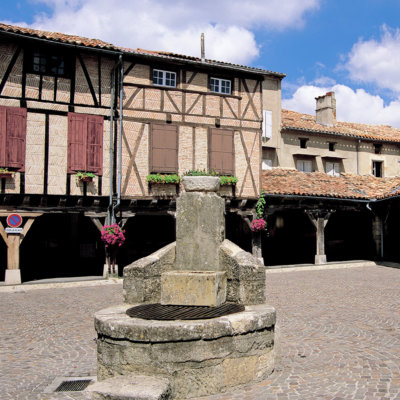
Cradle of the painter’s family Toulouse-Lautrec, the village is also known for its pink garlic which it is the capital. From its ramparts remains essentially the door of Caussade which leads to the central place where we still admire corbelled houses of the 14th century.
Perched above the valleys and hills of Quercy Blanc, this bastide was built in the 12th century by the Count of Toulouse and is located on via Podiensis, one of the roads leading to Santiago de Compostela. From this historical and religious past there are many testimonies: the central square and its ancient pavement, stone houses or half-timbered, pilgrim’s garden, etc.
About twenty kilometers north of Auch, the impressive castle of Lavardens, like a ship moored to a rocky outcrop, watches over the houses of the village and horizons rocked by green valleys. The former military capital of the Counts of Armagnac kept from the medieval times some vestiges of the ramparts and narrow carrels littered with hollyhocks over which one discovers charming mansions…
A Gothic bridge straddles the Loir to access this village nestled at the foot of a castle that resisted the assault of Richard the Lionheart but was taken by the troops of Henry IV. Today we can admire the remains of the enclosures and towers and its keep twenty-six meters high. In the village, styles and eras mix, from troglodyte houses to Gothic and Renaissance houses …
It was the Benedictine abbey established in the Middle Ages that made the Senouire Valley “the valley of God” which gave its name to the village. With its Romanesque cloister, and the Byzantine-inspired mural adorning its refectory, it is one of the jewels of Auvergne’s religious heritage. The village is in his image with vineyard houses with golden stones and round tiles …
Lavoûte-Chilhac benefits from an exceptional setting in the heart of the Gorges de l’Allier. Organized into two districts separated by a meander in the river and connected by a medieval bridge, the village exhibits the remains of its Cluniac priory and the facades of its houses built on the slope of the rock in the sun of this region of southern Auvergne.
Between Rouen and Lisieux, in a green landscape of groves and apple trees, Le Bec-Hellouin is a typical Normandy village with half-timbered houses and flowered balconies. It takes its name from the stream that borders it and from the founder of its famous abbey which, with the Benedictine monastery, testifies to the intense religious activity of the site.
About twenty kilometers from Montélimar, Le Poët-Laval settled in the Jabron Valley, surrounded by lavender and wheat. Old commandery of the order of Hospitallers, the village has preserved from this time the castle, remains of the Romanesque chapel of Saint-Jean-des-Commandeurs and ramparts.
At the confluence of the Dordogne and the Vézère, Limeuil experienced the throes of Viking invasions and the Hundred Years War, of which only the three fortified gates can still testify. Old harbor with intense commercial activity, the medieval village with stone houses and brown roofs typical of Périgord Noir is a charming and refreshing stop.
Taking its name from Saint-Ronan, hermit founder of the city in the tenth century, Locronan reached its peak in the sixteenth century thanks to the industry of sailcloth that had the largest sponsors including the East India Company. Wonderfully preserved, the granite city boasts beautiful Renaissance mansions and a magnificent 15th century church.
45 km south of Besançon, crossed by the Loue which flows in cascades, Lods is a village where forges and vineyards have long paced the lives of residents. From its past activities, the village has kept winemakers houses and created a museum of Vine and Wine and an ethnological journey telling the story of its old blacksmiths and winemakers.
Perched on a promontory from which one enjoys a superb panorama on the valley of the Dordogne and the castles around, Loubressac offers to the visitor the charm of its medieval houses with ocher stones and points of raised roofs. The church of Saint-Jean-Baptiste and the castle, manor of the XV and XVIII centuries, are well worth the small climb to access …
About twenty kilometers north of Uzès, Lussan embraces, behind its ramparts, a vast panorama opened on the Cevennes, the mountains of Ardèche and the Mont Ventoux. Throughout its narrow streets, the city reveals several centuries of history, conflicts between Catholics and Protestants at the advent of silk production.
Forty kilometers east of Rouen, in one of the most beautiful beech forests in Europe, Lyons the aptly named stretches its facades adorned with half-timbering, colored mud and bricks along the Lieure. The shops come alive around 18th century market halls, where there are also some jewels of local architecture such as the Vieux Logis or the former bailiwick became city hall.
Surrounded by deep gorges carved by the confluence of Brian and Cesse, placed at the end of a limestone plateau, Minerve is a mineral village in the heart of the Languedoc scrubland. Former Cathar Bastion destroyed by Simon de Monfort in 1210, the village keeps this time a stele in memory of a pyre Cathar.
Hidden behind the ramparts, intertwined in a labyrinth of narrow streets, the houses of Mirmande have preserved their beautiful stone facades and their old doors. After the disappearance, at the end of the 19th century, of silk worm breeding, it is the fruit production that assures Mirmande its development.
At the foot of Mont Saint-Odile, in a landscape of vineyards, this stronghold of the Zotzenberg grand cru is definitely marked by its wine culture: from the architecture of its vineyard houses open on large courtyards, to the “Weinschlag”, precious A collection of information on vineyards and wine since 1510, found behind the doors of the charming Renaissance town hall …
Located 25 kilometers south of Saint-Brieuc, the medieval city of Moncontour is still surrounded by the imposing ramparts of the 13th and 14th centuries, which allowed it to defend Lamballe, capital of Penthièvre. Like its local neighbor Locronan, until the Industrial Revolution, Moncontour was marked by the production of Berlingue (canvas linen and hemp) exported to the Indies.
Twenty kilometers north of Albi, Monestiés settled in a loop of Cérou an old stone bridge spans a few steps from the old fortified gate marking the entrance to the village. If the chapel Saint-Jacques no longer welcomes the pilgrims of Compostela, it contains within its exceptional furniture including a 15th century altarpiece composed of 20 polychrome statues.
Between Agenais and Périgord, this country house created in 1256 had to contain the numerous English attacks and to recover from the wars of Religion. If the city has lost its ramparts, it has nevertheless kept its characteristic plan checkerboard and Arcades place, still lively, still has beautiful homes in the image of the house of the Black Prince.
Grand national site, no less than 32 monuments listed as Historic Monuments, considered the model country house among the 300 bastides of the Great Southwest … There are countless honors awarded to Monpazier to greet, but also protect, the exceptional heritage of this bastide founded in 1284 by Edward I of England.∫
Overlooking a plain bathed in lavender, the high-rise houses of Montbrun-les-Bains protect the remains of an old medieval castle. From fountains to fountains, the calades lead to the bottom of the village where the newly renovated thermal establishment is reviving for twenty years the benefits of an ancient source …
Between Anjou and Touraine, Montsoreau’s prestigious setting is the Loire, a legendary river at the foot of which stands a 15th century castle made famous by Alexandre Dumas’ novel “The Lady of Monsoreau”. All around, flowery alleys with white tuffeau houses topped with slates and green paths lead to the vineyards of Saumur.
Former fishing and trading port, Mornac-sur-Seudre is today mainly focused on oyster farming and salt produced by its marshes. The village, typical of the Charente coast, discovers, along the streets, its houses with white facades and green or blue shutters sometimes hidden hollyhocks.
Nestled in the hollow of a meander of the Serein, Noyers offers visitors its two faces of medieval and winegrower. The places of la Petite-Etape-aux-Vins, the Marché-au-Blé or the Grenier-à-Sel are reminiscent of the flourishing era of activity, as are the beautiful half-timbered facades of the 15th century houses. agricultural and commercial village.
About thirty kilometers from Lyon, perched above the vineyards of Beaujolais, Oingt is one of the jewels of the “Land of golden stones”. From its medieval past, the city has preserved the old chapel of the castle, the fortified gate of Nizy and a keep tower from which one enjoys an exceptional panorama on the valley of Azergues.
In Picardy soil, Parfondeval concentrates, on a carpet of greenery, its habitat of red bricks and gray slate roofs with imposing volumes and its fortified church, typical of Thiérache. Almost entirely turned towards the agricultural activity, the village has for landscape orchards of apple trees, pastures and fields of corn … As in the countryside!
36 kilometers north-east of Lyon, at the top of a hill overlooking the Rhone plain, this ancient city of weavers keeps, behind its double walled enclosure, traces of its medieval past: old houses of the 15th-16th centuries , alleys with uneven pebbles, church-fortress … An exceptional architectural ensemble magnified by a contemporary lighting.
Former strategic place on the path leading from Gray to Dole, Pesmes knew a history agitated by the various occupations of which it was the object before becoming French in 1678 only. The city has nevertheless preserved a rich heritage: remains of the castle, church Saint-Hilaire of the thirteenth and sixteenth centuries … doors.
This hamlet in the commune of Comprégnac will definitely have a singular destiny: just 7 kilometers from Millau, its houses of clear stones stretch along a steep cliff, facing the highest viaduct in the world. In front of the semi-troglodyte church, an open square offers a breathtaking view of the structure and the green waters of the Tarn.
On the island of Beauty, at the entrance of the magnificent “calanche” of pink granite classified as World Heritage by UNESCO, Piana overlooks, in a dream setting, the Gulf of Porto. Dominated by the Italian-style Sainte-Marie church, the white houses arranged in amphitheatres are discovered along the way, from narrow streets to shaded squares with pleasant scents of eucalyptus …
From the top of a rocky plateau overlooking the valley of the Vère, the fortress of Puycelsi watches over the forest of Grésigne. Behind more than 800 m of ramparts, houses of stone, wood and bricks of XIVe or XVe S are revealed and the way of round gives superb points of view on the surrounding landscapes.
This pearl of Alsace has married the excellence of its wines to that of its architecture. The walk is savored and one takes full eyes of these flowered balconies, these carved windows and these old paved courtyards. Mansions from the 15th to the 18th century, castles of the princes of Württemberg, squares and fountains … Everything is magnificent!
Located 35 km east of Vannes, on a rocky hill dominating the valley of Gueuzon, the Breton city of Rochefort-en-Terre gives an impression of homogeneity in spite of the diversity of the architectural currents which were expressed there: houses
half-timbered, Gothic-style buildings, Renaissance mansions, classic hotels, 19th-century architecture …
In the land of the “Three Borders”, on the borders of France, Germany, where it is only 20 km away, and Luxembourg (6 km), Rodemack is bathed in this triple culture. Nicknamed the “Petite Carcassonne Lorraine”, the village is still surrounded by 700 m of ramparts dating from the 15th century and is entered through the fortified gate of Sierck, built by the inhabitants themselves in the 14th century.
Located in the heart of the largest ocher deposit in Europe, Roussillon proclaims its mineral singularity by an astonishing palette of flamboyant colors. Walking through its streets and stairways, contemplating its facades, often simple and naturally beautiful, you will admire the result of know-how more than millennia.
About twenty kilometers from Sarlat and a few steps from Lascaux, Saint-Amand-de-Coly has comfortably settled between two wooded valleys of the Vézère valley. Its 12th century abbey, considered as the most beautiful fortified church of Périgord, watches over the houses of the village which, like it, are made of this Sarlatese stone and these typical lauzes of the region in a harmonious contrast of ocher tones and Grey.
Twenty kilometers north-east of Romans-sur-Isère, in the heart of a hilly landscape, the abbey of Saint-Antoine watches over his village. Alongside the imposing building, considered one of the most remarkable Gothic works of the Dauphiné, are the simple houses in rubble or half-timbered suburbs, the old stalls and the medieval hall of the economic heart of the village.
At the crossroads of Berry and Limousin, on a granite rock overlooking the river, this ancient medieval town inhabited by Benedictine monks offers, behind its ramparts, a charming walk in its steep streets, to discover its houses of the fifteenth and XVIe S, its church and its priory but also the valley of the wallet on which the village offers a nice view.
C’est sur un promontoire rocheux que Bertrand, évêque de Comminges, fit bâtir la cathédrale Sainte-Marie, telle une vigie sur les Pyrénées. S’il doit sa notoriété au fabuleux édifice, le village recèle, derrière ses remparts et ses portes d’entrée, d’autres richesses telles ces maisons nobles du XVIe au XVIIIe S.
Perched on a cliff overlooking a meander of the Lot, Saint-Cirq-Lapopie is a masterpiece of medieval times. Dominated by the fortified church, houses with sloping roofs covered with brown tiles, discover their harmonious volumes along the picturesque streets. A place that charmed artists and writers like André Breton who made the village his summer residence.
In the department of Aveyron but on the banks of the Lot, Saint-Côme-d’Olt was built behind the ditches of the old fortified city.
The Flamboyant Gothic church with the flamed steeple, the Chapel of the Penitents and the Manor of the Sirs of Calmont, the 12th S alongside the old medieval stalls and the beautiful homes of the XV and XVI S in a set full of charm.
Step on the way to Compostela, Saint-Guilhem-le-Désert and its church, jewel of the Languedoc’s Romanesque art, occupy a wild site at the entrance of the Verdus gorges and the circus of the Infernet. From the Place de la Liberté and its imposing 150-year-old plane tree, the village spreads its narrow streets, still admiring Renaissance mullioned windows.
Crossed by the Côle, charming river that cracks a medieval bridge to beaks, this village with houses of ocher walls and brown tile roofs is a charming stage of the Périgord Vert. The history of Saint-Jean-de-Côle is linked to that of the 12th and 15th century Château de la Marthonie, which dominates the pretty Place Saint-Jean and to that of the priory, whose former Romanesque-Byzantine style church has original plan.
Located between the Basque coast and the Spanish border, on the right bank of the Nive and at the foot of the Cize passes (“Roncesvalles pass”), Saint-Jean-Pied-de-Port tells, through its heritage and architecture typical of the Basque Country, the many facets of its history: that of a step renowned for Saint-Jacques-de-Compostela, an old stronghold of the Kingdom of Navarre and a crossroads of trade always active.
A mi-chemin entre Lascaux et les Eyzies, cet ancien port florissant sur la Vézère s’inscrit dans un paysage typique du Périgord. Bien gardés par ses châteaux – le Manoir de la salle, à l’entrée du village, le château de Clérans, au-dessus de la rivière et le château de Chabans, fleuron de la côte de Jor – le village s’enorgueillit d’accueillir, dans la belle église romane du XIIe S, le festival Musical du Périgord Noir.
It is in a landscape of green hills, in the Vosges mountains, that Saint-Quirin settled, this, from the Gallo-Roman era as evidenced by the archaeological site of the Cross William. From a more recent past, the priory and its church with two towers with three bulbs superimposed testify to the religious vocation of the village in the thirteenth S. Tradition glassware and legend of the miraculous fountain also mingle in this pleasant stage.
Organized around a Benedictine monastery built by the disciples of Saint-Robert, the village experienced violent clashes. From this period, however, remains a beautiful fortified Romanesque church of the twelfth century and manor houses dressed in stone in a hilly landscape on the borders of Corrèze and Dordogne.
Belvedere on the estuary of the Rance, Saint-Suliac has long remained a village of terre-neuvas on which guarded the Virgin of Grainfollet. In the alleys where children run out of school, the flowers grow between the granite stones of the magnificent houses. Tidal mill, old salt mines, menhir … are among the local treasures that can be admired in a remarkably preserved site.
In the heart of the Queyras Regional Nature Park, at an altitude of 2,042 m, Saint-Véran boasts the highest inhabited municipality in Europe. In the village, consisting of several neighborhoods, wooden and stone chalets with slate roofs, fountains, bread ovens and sundials, are typical of the local “everyday” heritage, while the many chapels and mission crosses testify to the faith of the inhabitants.
Belvedere on the Mediterranean perched at nearly 800m above sea level, this former defense post of the Franco-Italian border on the Maginot Line has long been a coveted military site. Today, the village offers visitors eager for authenticity, its narrow streets paved with pebbles, its breathtaking view of the Côte d’Azur and its sunny climate.
At the heart of a hilly landscape of the Pilat Regional Nature Park, a chartreuse has become a village. If the houses occupy today a large part of the religious buildings of the site, the conventual church of the 17th century and its remarkable furniture, the kitchen of the Carthusians, the big cloister and a hermitage are open to the visit.
Located on the right bank of the Lot, Sainte-Eulalie is organized in arcs of circles around the church square, a masterpiece of Romanesque and Gothic art. In cobblestone cobbled streets of the Lot, the houses, passionately flowered by the inhabitants, date from the 15th to the 18th century.
Perched on a rocky peak dominating 70 meters the valley of Erve, between Laval and Le Mans, Sainte-Suzanne is best known as the medieval city that defied William the Conqueror. And yet … Its double ramparts and the rich heritage of that time still visible are not the oldest witnesses in the history of Sainte-Suzanne.
At 950 m altitude, in the Regional Natural Park of Auvergne Volcanoes, Salers is an essential stop in the region. A unique 16th century ensemble, its mansions and volcanic stone turreted houses give the village austere charm. Among the many rich heritage of the walled city, the Saint-Mathieu church contains five tapestries Aubusson seventeenth century, burial and lectern polychrome.
40 miles from Auch, in Gascon country, Sarrant wraps its tall houses of stone, mud and timber around the church of St. Vincent rebuilt and enlarged after the wars of religion. We enter the village through a vaulted door of the fourteenth century pierced by a massive square tower, witness of its medieval past.
Located on the peninsula of a loop of the Auvézère, Ségur-le-Château is, as its name suggests, a “safe place” that had chosen Viscounts of Limoges to establish their castle. If there remains today a keep of this edifice of the 12th century, noble houses with turrets or half-timberings testify in number of the splendid time that knew the village from the XV to the XVIIIth S, while Court of Appeals rendering justice on 361 lordships of the region.
At the foot of the Dentelles de Montmirail massif, overlooking the Rhone valley in a landscape of vineyards, Séguret is dominated by the tower of its old medieval castle. During the tour in the village, we discover the Reynier gate, a vestige of the fortifications, the fountain of Mascarons, the wash house and the belfry as well as the Romanesque church Saint-Denis …
A few kilometers from Fayence, Seillans has everything of the typical Provencal village: its houses built on a hillside, its cobbled streets, vaulted passages and squares where the fountain sings, its sunny climate and landscapes of vineyards and olive groves. The place seduced the painter Max Ernst who lived there the last years of his life and whose work can be admired at the Donation Tanning-Ernst.
In the south of Burgundy, this former stronghold of Saint-Hugues, founder of Cluny is the historic capital of Brionnais. In this beautiful village, the heritage does not fail, between the castle and its square tower of the 9th S, the magnificent Romanesque church Saint-Hilaire with its steeple with eight arches and columns and its carved portal or its old houses in the shade almost pink.
15 km south of Royan, on a rocky promontory overlooking the estuary of the Gironde, Talmont, has kept its original plan of bastide, built in 1284 by Edward I of Aquitaine. Dominating the village, the magnificent Sainte-Radegonde church, symbol of the Poitou-Charentes region, is still fortified with ramparts.
In the heart of the Cantal mountains, Tournemire is a charming green village on which watch the castle of Anjon, magnificent building with square body and four round towers. Around the Romanesque church of the 12th century, the houses of the 14th and 15th centuries, with their tufa stone walls and their lauze or slate roofs, are typical of the traditional Cantal house.
Perched at 635 m altitude, it is rightly that Tourtour is nicknamed “the village in the sky of Provence”. Stone houses with round tiles, the Place des Ormeaux and its eight fountains, vaulted passageways and sun-drenched streets … Everything is there! The enclosure of the medieval castle and the castle of the XVIIth century tell several past of the village …
Bearing the name of a powerful viscount who reigned over the Limousin, Perigord and Quercy for ten centuries, Turenne has kept many traces of its history: the Caesar and Treasury towers, remains of the castle overlooking the village, ancient private mansions from the 15th to the 17th century adorned with turrets or watch-towers and simpler mansions with roofs covered with slate or slate…
Clinging to a volcanic peak facing the Chaîne des Puys, the Dore Mountains and the Cézallier plateau, Usson and its black stone winemakers were once dominated by a castle that was for 19 years, the place of exile Queen Margot . South of the Romanesque church Saint-Maurice and the chapel of the queen, a path leads to the basaltic organs of the village.
At the foot of Mont Ventoux, clinging to a rocky peak dominating vineyards, garrigue and cherry trees, Venasque is an old medieval city which remains today the remains of the ramparts and three Saracen towers. In the heart of the Provencal village, we discover steep streets, houses of golden stones but also the Notre-Dame cathedral church and a magnificent baptistery from the 11th century.
Between Fecamp and Dieppe, installed on the plateau of Caux overlooking the cliffs of the Alabaster Coast, Veules-les-Roses offers all the attractions of a village between sea and countryside. Before flowing into the Channel, the Veules, the “smallest river in France”, offers a green and flowery route through the mills and thatched cottages, while villas and bath cabins recall the origins of the seaside resort.
Facing the Monts du Morvan, at the top of a steep hill, Sainte-Madeleine basilica, majestically watch over vineyard houses and Renaissance mansions. This masterpiece of Romanesque art restored in the 19th century by Viollet-le-Duc, makes of Vézelay a high place of pilgrimage and a point of departure towards Compostela.
This ancient trading city capital of Conflent has kept very beautiful traces of its history and its status as a defensive site. Thus, the ramparts and the tower of the Viguerie, built by the Count of Cerdagne in the 11th century, then reinforced by the fortifications of Vauban in the 17th century and the Fort Liberia, recently listed as World Heritage by UNESCO, or the stalls and houses of notables or rich traders …
Located between Bergerac in the North and Villeneuve-sur-Lot in the South, the Royal Country House of Villeréal, founded in 1267 by Alphonse de Poitiers, offers a typical structure of these “new towns” built in the Middle Ages in the South West of France : its square at the angles, which still houses the commercial activity of the village, and its streets at right angles over which coexist wood sides and facades of gilded stone.
On the banks of the Ardèche, leaned against a cliff, the castle of the Lords of Vogüé and its four round towers watch over the village and its narrow streets in amphitheater lined with arcades and vaulted passageways. The pretty houses with warm colors and round tile roofs testify to the southern character of the city.
Enclosed in a loop of the Mère river, behind a fortified wall still well preserved, Vouvant was born from the legend of Mélusine, ancestor of the counts of Lusignan who would have given, in one night, a castle in the village. From this building only remains, watching over the houses coated with lime, the dungeon called “Tour Mélusine”. The magnificent Romanesque church of the 11th century is a must visit.
Between Paris and Orleans, Yèvre-le-Châtel combines the strength of its ramparts and its 13th century castle, overlooking the Romanesque Saint-Gault church and the unfinished nave of Saint-Lubin, with the charm of its flowery alleys, its old limestone houses and gardens that inspire international painters and artists.
Stone houses with wooden balconies, alleys full of wisteria and geraniums … It is called “the pearl of Lake Geneva. Dominating the shores of the lake which made the village a port of fishermen and boatmen, the square keep is one of the remains of the medieval past of Yvoire which celebrated, in 2006, the 700 years of its fortifications erected by Amédée V le Grand, Count of Savoy.
